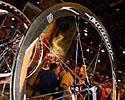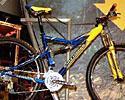
|
Eurobike EICMA Cycle 2002 Interbike Australia Tokyo 2002 Chris Davidson Diary |
|
Tokyo pics Australia pics Interbike pics Cycle 2002 pics EICMA pics Eurobike pics |
Recently on Cyclingnews.com |
Interbike 2002
Las Vegas, USA, October 5 - 8, 2002
Interbike part 12 - Trek's arsenal grows:
LA-inspired OCLVs for all, Ti/carbon LeMonds and a Maverick rear-end for Klein
By Gerard Knapp in Las Vegas
 |
The Trek stand at Interbike always features one of the widest ranges of bikes on display and the 2003 range will be no exception. Although there are only slight changes to its category-leading OCLV road racing bikes, the LeMond and Klein brands in particular featured radical new models, with MTBs using licensed suspension technology from Maverick and the classy LeMond roadsters featuring a new model with a carbon fibre upper and titanium spine.
But the Trek OCLVs carbon bikes still take pride of place, whether they are for the road or dirt. With riders such as Lance Armstrong and the US Postal Service team, or Roland Green and the Trek-Volkswagen MTB team, the company has two of the most well-known and successful North American riders on its books. Subsequently, the stand is decorated with huge prints of Armstrong in yellow and Green in the rainbow jersey.
 |
For those really into dirt, Green's Fuel MTB bike was not preserved for posterity after his win in this year's epic World MTB Championships in Kaprun, Austria, described as the best worlds ever by many experienced MTB experts. Instead, it was washed afterwards. Your correspondent expected to see the mud-encrusted MTB kept in a glass case, untouched after he crossed the line last month, but maybe only Italians think of doing things like that. They could have also kept his shoes, held onto his feet by gaffer tape as the thick mud may have sucked them free when - like all other competitors - he was forced to pick up his bike and run through some of the worst sections of the course. Instead, they were all shiny new models gracing the stand.
For the road OCLVs, all models now have straight OCLV forks with aluminium streerer tubes: "Lance won't use carbon," quipped Trek's Mike Mayer. Previously, this fork was only used on the 5900 Superlight. New for 2003 is a Women's Specific Design OCLV 5200, which required a US$100K investment in new lugs to achieve the WSD geometry. Mayer explained that most of the women buying this high-end road machine aren't planning to race; rather, it seems they are Lance-alikes wanting to emulate their hero. A further indication of the OCLV customer is that 60 percent of these machines are now sold with triple sets on the front.
 |
To help OCLV owners make their bikes more personalised, Trek has ramped up its Project One customisation program. Introduced last year by offering a range of different paint schemes, the higher-end machines can now be customised down to the component level - and this goes across the Trek, LeMond and Klein ranges - with custom paint offered on tandems and pavement models.
Mayer added that next year, Armstrong and all the USPS team will use Bontrager wheels for all stages of the Tour, a response to a question about the Topolino lightweight carbon wheels Armstrong used on the mountain stages of this year's TdF.
 |
On the MTB side, Trek is offering an all-carbon dual suspension cross country bike, the Fuel 100, as ridden by Roland Green in a couple of MTB World Cup rounds this year (he won both). The Fuel 100 also features a carbon suspension linkage to keep weight down. The Fuel 9.8 hardtail world championship bike remains pretty much the same, except for lighter tubeless Bontrager wheels, lighter bar, stem and seatpost.
A more versatile dually from Trek is the Liquid range which offers tuneable suspension on-the-fly (from 4 - 5"),using the Talas Fox rear shock. All frames in the range are made from aluminium.
The big change in pricing is to the Diesel downhill and freeride bikes, as Trek has improved manufacturing on these models and can offer a complete bike for only US$500 more than the frame cost last year.
 |
The other two MTB brands offered by the Wisconsin firm, Fisher and Klein, featured some new dirt models. Of particular interest was the use of Maverick rear suspension technology on the Palomino range from Klein. This suspension system is said to eliminate bobbing under hard pedaling and any travel of the rear wheel over obstacles does not impact on pedaling action.
While the Klein MTBs sport conventional drop-outs, the road machines continue to use the reverse drop-outs which have created some comment in Europe, where Klein provides bikes to the Gerolsteiner team of Davide Rebellin. The Q-Pro Carbon Series is relatively unchanged from last year, but new for 2003 will be the Compact Carbon, which features a sloping top tube and carbon rear end. A complete Q-Pro Carbon with Dura Ace and Bontrager wheels is aid to weigh in at only 7.5kg, still above the UCI's 6.8kg minimum.
 |
Meanwhile, Gary Fisher persists with the 29" wheels on his MTBs. One advantage of these bikes is that owners can fit a wider range of road rubber to the 700C wheels, while the bigger wheels are also said to be easier to ride in soft dirt and over large obstacles when off-road. The big wheels are fitted to the Sugar dual-suspension models and the Genesis hardtails. Fisher's 29" wheeled Sugar 292 has 3.1 - 4.6 inches of travel, up from the 2.8" - 4.1" of the 26". Of course, Fisher also offers the 26" wheel models and now has a disc-brake version of the Big Sur.
 |
Back on the road and the LeMond brand introduced a new Tete de Course model featuring a butted, shaped Reynolds Ti spine merged with an OCLV upper. As Cyclingnews' Yorkshire-born tech editor John Stevenson once said, combining Ti with carbon on the one frame is "probably the most mind-buggeringly expensive way to build a bicycle known to man". Apparently they ride very nicely.
The LeMond range expanded its offerings in the Project One area with a wider range of components and paint schemes to cover up that dull grey Ti tubing. In 2003, LeMond also continues with its Reynolds 853 steel bikes such as the Maillot Jaune and Zurich models.
More information can be found at www.trekbikes.com
Photos
Images by Rob Karman/www.roadbikephotos.com
- Bontrager Racelite carbon forks
- Bontrager carbon wheels
- Bontrager lightweight machined rim
- Gary Fisher's Sugar 29'er
- Klein's new Maverick based bike, the Palamino
- Klein Q Carbon race
- Klein Q Carbon
- LeMond's Carbon and Ti road bike
- Another look at the LeMond
- Ti lugs and carbon is big this year
- Another Ti frame by LeMond
- The Trek 5200 Triple in black/pearl/carbon
- Trek's new touring/sport bike
- The access port on the Trek
- Trek's Diesel now comes in a "freeride" flavour
- The new Trek Fluid
- Trek's 100mm travel Fuel, great for those longer rides
- One of many options from Trek's Project One
- So many Project one bikes, they were hanging from the roof
